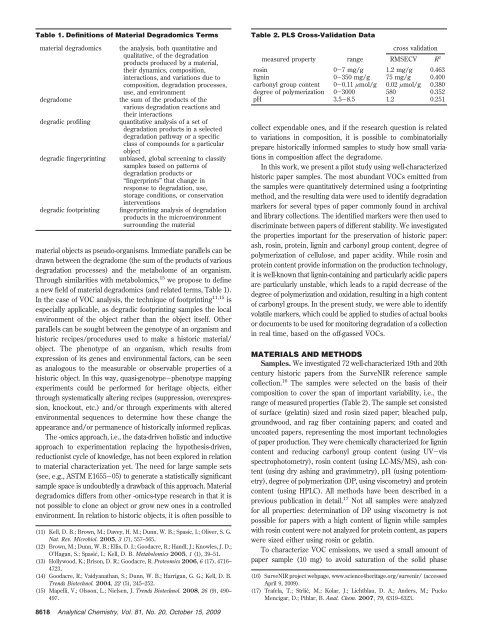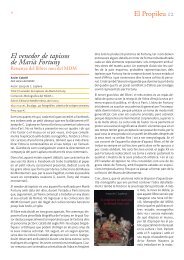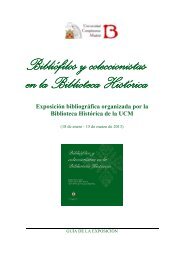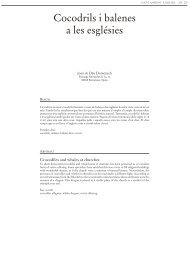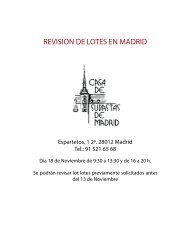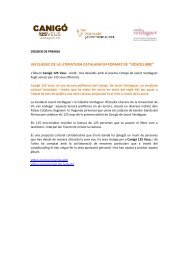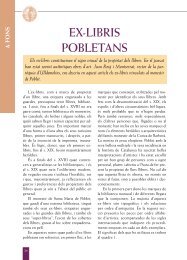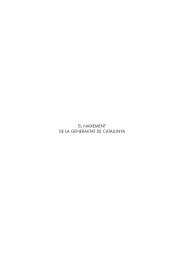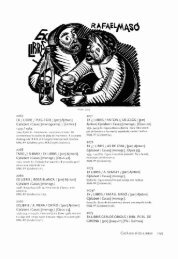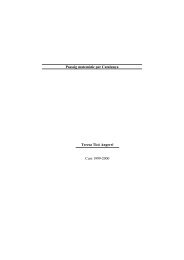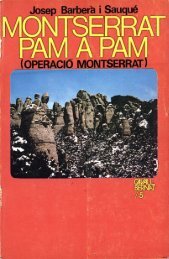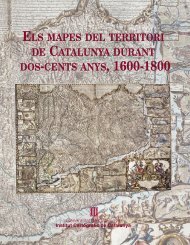Material Degradomics: On the Smell of Old Books
Material Degradomics: On the Smell of Old Books
Material Degradomics: On the Smell of Old Books
Create successful ePaper yourself
Turn your PDF publications into a flip-book with our unique Google optimized e-Paper software.
Table 1. Definitions <strong>of</strong> <strong>Material</strong> <strong>Degradomics</strong> Terms<br />
material degradomics <strong>the</strong> analysis, both quantitative and<br />
qualitative, <strong>of</strong> <strong>the</strong> degradation<br />
products produced by a material,<br />
<strong>the</strong>ir dynamics, composition,<br />
interactions, and variations due to<br />
composition, degradation processes,<br />
use, and environment<br />
degradome <strong>the</strong> sum <strong>of</strong> <strong>the</strong> products <strong>of</strong> <strong>the</strong><br />
various degradation reactions and<br />
<strong>the</strong>ir interactions<br />
degradic pr<strong>of</strong>iling quantitative analysis <strong>of</strong> a set <strong>of</strong><br />
degradation products in a selected<br />
degradation pathway or a specific<br />
class <strong>of</strong> compounds for a particular<br />
object<br />
degradic fingerprinting unbiased, global screening to classify<br />
samples based on patterns <strong>of</strong><br />
degradation products or<br />
“fingerprints” that change in<br />
response to degradation, use,<br />
storage conditions, or conservation<br />
interventions<br />
degradic footprinting fingerprinting analysis <strong>of</strong> degradation<br />
products in <strong>the</strong> microenvironment<br />
surrounding <strong>the</strong> material<br />
material objects as pseudo-organisms. Immediate parallels can be<br />
drawn between <strong>the</strong> degradome (<strong>the</strong> sum <strong>of</strong> <strong>the</strong> products <strong>of</strong> various<br />
degradation processes) and <strong>the</strong> metabolome <strong>of</strong> an organism.<br />
Through similarities with metabolomics, 15 we propose to define<br />
a new field <strong>of</strong> material degradomics (and related terms, Table 1).<br />
In <strong>the</strong> case <strong>of</strong> VOC analysis, <strong>the</strong> technique <strong>of</strong> footprinting 11,15 is<br />
especially applicable, as degradic footprinting samples <strong>the</strong> local<br />
environment <strong>of</strong> <strong>the</strong> object ra<strong>the</strong>r than <strong>the</strong> object itself. O<strong>the</strong>r<br />
parallels can be sought between <strong>the</strong> genotype <strong>of</strong> an organism and<br />
historic recipes/procedures used to make a historic material/<br />
object. The phenotype <strong>of</strong> an organism, which results from<br />
expression <strong>of</strong> its genes and environmental factors, can be seen<br />
as analogous to <strong>the</strong> measurable or observable properties <strong>of</strong> a<br />
historic object. In this way, quasi-genotype-phenotype mapping<br />
experiments could be performed for heritage objects, ei<strong>the</strong>r<br />
through systematically altering recipes (suppression, overexpression,<br />
knockout, etc.) and/or through experiments with altered<br />
environmental sequences to determine how <strong>the</strong>se change <strong>the</strong><br />
appearance and/or permanence <strong>of</strong> historically informed replicas.<br />
The -omics approach, i.e., <strong>the</strong> data-driven holistic and inductive<br />
approach to experimentation replacing <strong>the</strong> hypo<strong>the</strong>sis-driven,<br />
reductionist cycle <strong>of</strong> knowledge, has not been explored in relation<br />
to material characterization yet. The need for large sample sets<br />
(see, e.g., ASTM E1655-05) to generate a statistically significant<br />
sample space is undoubtedly a drawback <strong>of</strong> this approach. <strong>Material</strong><br />
degradomics differs from o<strong>the</strong>r -omics-type research in that it is<br />
not possible to clone an object or grow new ones in a controlled<br />
environment. In relation to historic objects, it is <strong>of</strong>ten possible to<br />
(11) Kell, D. B.; Brown, M.; Davey, H. M.; Dunn, W. B.; Spasic, I.; Oliver, S. G.<br />
Nat. Rev. Microbiol. 2005, 3 (7), 557–565.<br />
(12) Brown, M.; Dunn, W. B.; Ellis, D. I.; Goodacre, R.; Handl, J.; Knowles, J. D.;<br />
O’Hagan, S.; Spasić, I.; Kell, D. B. Metabolomics 2005, 1 (1), 39–51.<br />
(13) Hollywood, K.; Brison, D. R.; Goodacre, R. Proteomics 2006, 6 (17), 4716–<br />
4723.<br />
(14) Goodacre, R.; Vaidyanathan, S.; Dunn, W. B.; Harrigan, G. G.; Kell, D. B.<br />
Trends Biotechnol. 2004, 22 (5), 245–252.<br />
(15) Mapelli, V.; Olsson, L.; Nielsen, J. Trends Biotechnol. 2008, 26 (9), 490–<br />
497.<br />
8618 Analytical Chemistry, Vol. 81, No. 20, October 15, 2009<br />
Table 2. PLS Cross-Validation Data<br />
cross validation<br />
measured property range RMSECV R2 rosin 0-7 mg/g 1.2 mg/g 0.463<br />
lignin 0-350 mg/g 75 mg/g 0.400<br />
carbonyl group content 0-0.11 µmol/g 0.02 µmol/g 0.380<br />
degree <strong>of</strong> polymerization 0-3000 580 0.352<br />
pH 3.5-8.5 1.2 0.251<br />
collect expendable ones, and if <strong>the</strong> research question is related<br />
to variations in composition, it is possible to combinatorially<br />
prepare historically informed samples to study how small variations<br />
in composition affect <strong>the</strong> degradome.<br />
In this work, we present a pilot study using well-characterized<br />
historic paper samples. The most abundant VOCs emitted from<br />
<strong>the</strong> samples were quantitatively determined using a footprinting<br />
method, and <strong>the</strong> resulting data were used to identify degradation<br />
markers for several types <strong>of</strong> paper commonly found in archival<br />
and library collections. The identified markers were <strong>the</strong>n used to<br />
discriminate between papers <strong>of</strong> different stability. We investigated<br />
<strong>the</strong> properties important for <strong>the</strong> preservation <strong>of</strong> historic paper:<br />
ash, rosin, protein, lignin and carbonyl group content, degree <strong>of</strong><br />
polymerization <strong>of</strong> cellulose, and paper acidity. While rosin and<br />
protein content provide information on <strong>the</strong> production technology,<br />
it is well-known that lignin-containing and particularly acidic papers<br />
are particularly unstable, which leads to a rapid decrease <strong>of</strong> <strong>the</strong><br />
degree <strong>of</strong> polymerization and oxidation, resulting in a high content<br />
<strong>of</strong> carbonyl groups. In <strong>the</strong> present study, we were able to identify<br />
volatile markers, which could be applied to studies <strong>of</strong> actual books<br />
or documents to be used for monitoring degradation <strong>of</strong> a collection<br />
in real time, based on <strong>the</strong> <strong>of</strong>f-gassed VOCs.<br />
MATERIALS AND METHODS<br />
Samples. We investigated 72 well-characterized 19th and 20th<br />
century historic papers from <strong>the</strong> SurveNIR reference sample<br />
collection. 16 The samples were selected on <strong>the</strong> basis <strong>of</strong> <strong>the</strong>ir<br />
composition to cover <strong>the</strong> span <strong>of</strong> important variability, i.e., <strong>the</strong><br />
range <strong>of</strong> measured properties (Table 2). The sample set consisted<br />
<strong>of</strong> surface (gelatin) sized and rosin sized paper; bleached pulp,<br />
groundwood, and rag fiber containing papers; and coated and<br />
uncoated papers, representing <strong>the</strong> most important technologies<br />
<strong>of</strong> paper production. They were chemically characterized for lignin<br />
content and reducing carbonyl group content (using UV-vis<br />
spectrophotometry), rosin content (using LC-MS/MS), ash content<br />
(using dry ashing and gravimmetry), pH (using potentiometry),<br />
degree <strong>of</strong> polymerization (DP, using viscometry) and protein<br />
content (using HPLC). All methods have been described in a<br />
previous publication in detail. 17 Not all samples were analyzed<br />
for all properties: determination <strong>of</strong> DP using viscometry is not<br />
possible for papers with a high content <strong>of</strong> lignin while samples<br />
with rosin content were not analyzed for protein content, as papers<br />
were sized ei<strong>the</strong>r using rosin or gelatin.<br />
To characterize VOC emissions, we used a small amount <strong>of</strong><br />
paper sample (10 mg) to avoid saturation <strong>of</strong> <strong>the</strong> solid phase<br />
(16) SurveNIR project webpage, www.science4heritage.org/survenir/ (accessed<br />
April 9, 2009).<br />
(17) Trafela, T.; Strlič, M.; Kolar, J.; Lichtblau, D. A.; Anders, M.; Pucko<br />
Mencigar, D.; Pihlar, B. Anal. Chem. 2007, 79, 6319–6323.


